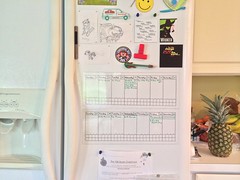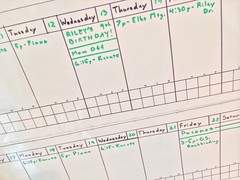 We use shared Google Calendars for our family calendaring. Each of us has his/her own calendar, and we have a shared calendar for stuff that we all participate in. But when we're sitting in the kitchen with the kids at meals, particularly while getting ready for school in the morning, it would be nice not to have to fish out the phones and cross-reference, and blah blah blah.
We use shared Google Calendars for our family calendaring. Each of us has his/her own calendar, and we have a shared calendar for stuff that we all participate in. But when we're sitting in the kitchen with the kids at meals, particularly while getting ready for school in the morning, it would be nice not to have to fish out the phones and cross-reference, and blah blah blah.
I set out to find a solution to this issue. The obvious solution is a traditional calendar. Berta bought one and added October's events to it, but it had some of the traditional problems.
First, there wasn't anywhere useful to put the monthly paper calendar. We never had one before, so we didn't have a place to keep it. The spots it ended up were first on the kitchen island, where it was always in the way, and then on the wall under some hung photos, which not only wasn't a readily visible location, but was behind some hung photos.
Second, it had these weird "Mine/Theirs" rows. I assume this was a nod to some parent who organizes the family events. Personally, I find this insulting.
Third, and this is really where my imagination starts to kick in, you can only see the current month on the paper calendar. When half the month is over, half of what is being shown is useless to you. Worse, when you get closer to the end of the month, you have to flip back and forth between pages to see what's coming up. What's coming up is the most important part!
One might suggest that we use one of those dry-erase magnetic fridge calendars. As you can see though, it fails for many of the same reasons that the paper calendar fails. Worse, there's no next month at all on a single magnetic calendar. And they also all seem to have that demeaning "Mine/Theirs" crap, too.
What's a person to do?
My Solution
 It's not complicated. I bought a large sheet of dry-erase magnet from Amazon. The sheet was 11x17, and I cut it down to two strips of 5.5x15. On each strip, I drew a week's worth of boxes for each day with a Sharpie, labeling them with the day name and a blank box. At the bottom of each box, I included two rows of small boxes labeled H, C, and P, for Homework, Chores, and Practice.
It's not complicated. I bought a large sheet of dry-erase magnet from Amazon. The sheet was 11x17, and I cut it down to two strips of 5.5x15. On each strip, I drew a week's worth of boxes for each day with a Sharpie, labeling them with the day name and a blank box. At the bottom of each box, I included two rows of small boxes labeled H, C, and P, for Homework, Chores, and Practice.
Here's the plan: With a fine point wet-erase marker, I fill in the current week's worth of date numbers in the blank boxes next to the weekday names. In the large area, I write all of each day's events and their times, just like you would on a paper calendar.
The bottom area is a bit of an experimental hack. The idea is that there is one row for each kid (they're labeled A and R), and as they each complete the task for which the box is designated, they mark it with an X. Consecutive X days will earn prizes, and (even better) end up with all of the homework, chores, and instrument practices being completed.
I follow this same process for next week, and then put both magnets on the fridge, one above the other. When this week is over, I erase the events from this week (easily done, while leaving behind the permanent Sharpie-rendered calendar design) and fill in the next week. I move up the existing week and put the new week underneath. And so on.
The weird and important bit to mention is that although the sheet is a dry-erase board, I'm using it with wet-erase markers. Why? Dry erase markers can be too easily erased by casual bumping. With a high-traffic area like the fridge, you want a slightly more permanent solution. Wet-erase markers actually require some water to remove the markings. They also come off of the board more cleanly, whereas the dry-erase markers leave ghost images and odd smudges.
I'm enthusiastic about this solution. I think it's a nice compromise between writing a ton of future dates that could get stale onto a paper calendar and being able to see what's happening in the near-term. I like that it's analog and easily editable, and how it solves many of the issues with a traditional calendar. It won't be our canonical reference - the Google Calendar will still serve that function - but it will at least give us the "at a glance" reference that is useful for planning our weeks while simultaneously tracking essential chore completion duties.